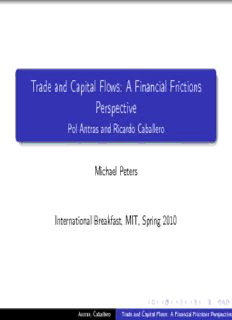
Trade and Capital Flows: A Financial Frictions Perspective PDF
Preview Trade and Capital Flows: A Financial Frictions Perspective
Trade and Capital Flows: A Financial Frictions Perspective Pol Antras and Ricardo Caballero Michael Peters International Breakfast, MIT, Spring 2010 Antras,Caballero TradeandCapitalFlows: AFinancialFrictionsPerspective Motivation of the Paper Classical HO view: Trade and Capital Mobility are substitutes, i.e. trade reduces incentives to move capital to the south Reasoning: Stolper-Samuelson implies that wages increase and rental rates decrease in the South With financial frictions: Trade and Capital Mobility are complements, i.e. trade increases incentives to move capital to the south Reasoning: 1 Trade reduces misallocation of resources by decoupling production and consumption decisions 2 Improved resource allocation increases rental rates Antras,Caballero TradeandCapitalFlows: AFinancialFrictionsPerspective The Basic Intuition of the Mechanism Financial Friction: Sector 1 can only use K units of capital Low Sector 2 therefore uses K units of capital High “Efficient” allocation of labor: L =L >>L =L 2 High 1 Low But: Consumers disagree with that - they want both goods. ⇒ Capital-Labor-Ratios not equalized across sector ⇒ In particular: k too high so that rental rate is low 2 Hence: Financial Friction + Demand ⇒ Misallocation of Factors Note: If goods are perfect substitutes, financial constraints have no effect Role of Trade: Decouple production and consumption decision ⇒ Reduce misallocation ⇒ Increase rental rates Antras,Caballero TradeandCapitalFlows: AFinancialFrictionsPerspective This Talk 1 Present the basic model (Cobb-Douglas technology/preferences, countries differ only in financial constraint) 1 Autarky, No Frictions 2 Autarky, Frictions 3 Trade, Frictions 4 Capital Mobility and Trade 2 Robustness with respect to 1 functional form assumptions 2 asymmetric technologies across sectors 3 asymmetric factor supplies across countries 4 Dynamic Environment Antras,Caballero TradeandCapitalFlows: AFinancialFrictionsPerspective Basic Environment Cobb-Douglas Preferences (cid:18)C (cid:19)η(cid:18) C (cid:19)1−η 1 2 U = η 1−η Symmetric Cobb-Douglas Technology F (K ,L )=ZKαL1−α for i =1,2 i i i i i Prices (p ,p )=(1,p) 1 2 No frictions on labor markets Antras,Caballero TradeandCapitalFlows: AFinancialFrictionsPerspective Autarky, No Frictions Good Market Clearing: η Y kαL = 1 = 1 1 (1) 1−η pY pkαL 2 2 2 MPL is equalized across sector MPL (1−α)Zkα kα MPK kα−1 1= 1 = 1 = 1 = 1 = 1 (2) pMPL p(1−α)Zkα pkα pMPK pkα−1 2 2 2 2 2 From (1): K k =k = =k 1 2 L From (1) and (2): L =ηL and L =(1−η)L 1 2 Antras,Caballero TradeandCapitalFlows: AFinancialFrictionsPerspective Autarky Equilibrium, No Frictions Equilibrium K K L 1 = L1 = η and 2 = 2 =1−η K L K L (cid:18)k (cid:19)α (cid:18)K/L(cid:19)α 1 p = = =1 k K/L 2 w = (1−α)Zkα R = αZkα−1 With trade: Complete specialization if p∗(cid:54)=1. Antras,Caballero TradeandCapitalFlows: AFinancialFrictionsPerspective Financial Frictions Population consists of L workers, µ entrepreneurs and 1−µ rentiers Sector 1 is constrained in that 1 Only entrepreneurs can use its technology 2 Entrepreneur e faces borrowing constraints in that Ie ≤θKe, θ >1 1 Aggregate endowment for sector 1: K ≤θ(µK)<ηK 1 Holds with equality if E only invest in sector 1 (which will be the case) Antras,Caballero TradeandCapitalFlows: AFinancialFrictionsPerspective Autarky Equilibrium with Frictions Above we used only GM and LM to get η Y Y /L L L L 1 1 1 1 1 1 = = = → =η. 1−η pY pY /L L L L 2 2 2 2 2 Hence: Labor Allocation is not affected by frictions. Reason: 1 CD Demand: Value-Share of Production is constant 2 CD Production: MPL∝APL so that p has to do “all the work” E.g. Different with CES-Demand: Y L ηpσ−1= 1 = 1 pY L 2 2 Antras,Caballero TradeandCapitalFlows: AFinancialFrictionsPerspective Autarky Equilibrium with Frictions Capital-Labor-Ratios: K /K θµ 1−θµ 1 k (θ)= k = k <k < k =k (θ) 1 2 L/L η 1−η p decreases due to “excess supply” of Y 2 (cid:18)k (θ)(cid:19)α p(θ)= 1 <1=pNF k (θ) 2 Wages are low w(θ)=(1−α)Zk (θ)α <wNF 1 Return to capital in sector 2 are low δ(θ)=αZp(θ)k (θ)α−1<αZkα−1=δNF 2 Misallocation in this economy MPK k (θ)α−1 k (θ) 1 1 2 ξ(θ)= = = >1 pMPK2 p(θ)k2(θ)α−1 k1(θ) Antras,Caballero TradeandCapitalFlows: AFinancialFrictionsPerspective
Description: